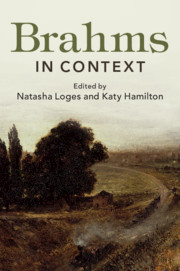Book contents
- Brahms in Context
- Brahms in Context
- Copyright page
- Dedication
- Contents
- Illustrations
- Music Examples
- Notes on Contributors
- Preface
- Abbreviations
- Part I Personality, People and Places
- Part II Identities, Environments and Influences
- Chapter 8 Finances
- Chapter 9 As Pianist
- Chapter 10 As Conductor
- Chapter 11 As Arranger
- Chapter 12 As Editor
- Chapter 13 As Teacher
- Chapter 14 Private Music-Making
- Chapter 15 Concert Life
- Chapter 16 Genre
- Chapter 17 Folk Music
- Chapter 18 Early Music
- Part III Performance and Publishing
- Part IV Society and Culture
- Part V Reception and Legacy
- Further Reading
- Index
- References
Chapter 16 - Genre
from Part II - Identities, Environments and Influences
Published online by Cambridge University Press: 15 May 2019
- Brahms in Context
- Brahms in Context
- Copyright page
- Dedication
- Contents
- Illustrations
- Music Examples
- Notes on Contributors
- Preface
- Abbreviations
- Part I Personality, People and Places
- Part II Identities, Environments and Influences
- Chapter 8 Finances
- Chapter 9 As Pianist
- Chapter 10 As Conductor
- Chapter 11 As Arranger
- Chapter 12 As Editor
- Chapter 13 As Teacher
- Chapter 14 Private Music-Making
- Chapter 15 Concert Life
- Chapter 16 Genre
- Chapter 17 Folk Music
- Chapter 18 Early Music
- Part III Performance and Publishing
- Part IV Society and Culture
- Part V Reception and Legacy
- Further Reading
- Index
- References
Summary
The two passages of music below might be taken, by a musician who had not yet encountered them, to come not only from the pen of very different composers but from very different eras. The first (Example 16.1) seems to be from the early to middle part of the nineteenth century. Its theme – songlike in form but clearly instrumental in tessitura and technique – unfolds exuberantly upward against a cloud of oscillating strings, a sensuous texture retained by at least some of the instruments almost continually until the theme lands on a cadence at bar 16. This opening seems inspired byFelix Mendelssohn’s celebrated Octet Op. 20, whose beginning is remarkably similar, although Mendelssohn’s theme is presented by violin rather than cello Example 16.2). In both chamber pieces, too, the outer elements of the texture come to play off each other melodically as the theme unfurls.
- Type
- Chapter
- Information
- Brahms in Context , pp. 149 - 163Publisher: Cambridge University PressPrint publication year: 2019

